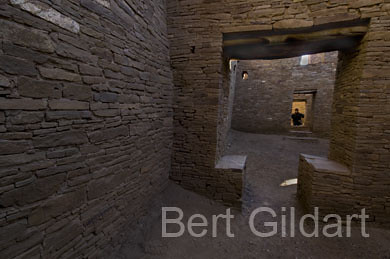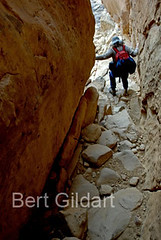Though Brutally Cold, The “Chaco Phenomena” Still Fascinated Us
©Bert Gildart: Cold! That’s what much of this past week has been about, though we have nevertheless hiked through one of the nation’s best preserved series of ancient ruins, which are located at Chaco Canyon in New Mexico.
Almost one week ago now to the day, we pulled our Airstream along a road that might best be described as one containing about 20 miles of continuous speed bumps. Some drivers departing Chaco choose to go “hell bent for leather,” but we value our tag-along-domicile, so put our Dodge in four-wheel-drive low, selected first gear and then crept the entire distance, taking almost two hours to navigate the road. It was worth the effort!
When we arrived our good friends, Sue and Eric Hansen, had already set up their camp. It was almost dark, but a full moon was rising, and it was illuminating our campground and an ancient pueblo, which formed part of our camping atmosphere. Soon a coyote began to howl. Certainly, this is a remote setting, and for the many people who’ve been trying to reach us, there is no communication here: no cell phone and no internet. Adding to the sense of remoteness has been the intense cold, which several days ago dipped to ten degrees below zero! Though the campground can accommodate dozens, we saw only one other couple – and they were tent campers! But like us, we later learned, they, too, were anxious to explore this incredible park – and learn all they could despite the cold.
THE CHACO PHENOMENA
At Chaco Culture National Historical Park, located south of Farmington, New Mexico, North America’s most spectacular grouping of ruins rise from the landscape. From the many visits Janie and I have made here previously, we know that these incredible ruins have come to be known as the Chaco phenomena. Here at Chaco, a remarkable culture reached its zenith. But it didn’t happen overnight. Like other Hisatsinom (the term that has replaced the word Anasazi), Chacoans began their immense journey across the Four Corners living first in caves. With time, they learned they could shape the abundant stone and rock to their needs.
Click on above to see enlarged version and for extended captions
Initially, their structures were rudimentary. But beginning about 850 AD, these primordial people began to transform their moderate-sized structures into grand houses. Over the next 250 years, these ancients built dozens of great houses in and around Chaco Canyon. Some were so extraordinary that when the Spanish first saw them in the 1500’s, they endowed them with appellations such as Casa Grande and Pueblo Bonito—that “most elaborate of all ruins.”
EXPLORING BY HIKING
Possibly the best way to appreciate the sophistication of the Chacoan culture is to hike one of the park’s many trails. A many-storied trek departs from the parking lot near Kin Kletso ruin, and that is what Janie, Sue, Eric and I did. Among other things, the trail passes along an ancient road honed by Chacoans. Along the way the trail overlooks the Jackson Staircase, named for the famous photographer who documented the steps in the late 1800’s.
Once the steps provided Chacoans with access from the valley floor to the bench land overhead. Some of these roads were 30-feet wide and they led to many outliers spaced about a day’s walk apart. Incredibly, sections of these roads still exist, and their edges remain lined with rocks that Chacoans piled here 800 years ago—still telling their story!
PUEBLO BONITO
The trail also leads to an overlook that peers down onto Pueblo Bonito, meaning “house beautiful.” About 1200 A.D. Pueblo Bonito was the largest and grandest of them all, rising four or five stories and was honeycombed with more than 650 rooms and approximately 35 kivas.
What a sight it must have been to watch the day-to-day activities of the ancients applying their considerable masonry skills to the growing walls and family rooms. Each household, we’re told, consisted of a family of five to ten people, including children, parents and grandparents. Typically, room features incorporated a shallow fire pit, stone-lined hearths, pot rests, mealing bins, wall niches and elevated vents.
Still, the most impressive feature of Pueblo Bonito remains the great kiva—a huge circular depression sunk in the ground and fortified by hand-hewn bricks. As the sun descended and the oblique light intensified, glorifying the kiva, it was impossible not to appreciate Hisatsinom spirituality.
WHY DID THE ANCIENTS LEAVE?
Why, then, did the ancients leave?
There are many theories, and one suggests the resources had been overused. Yet another theory suggests that there was evidence of eliticism, for some rooms within these ruins preserve only the remains of great chiefs (for lack of a better term), and some of the rocks suggest they secured this eternal rest forcefully. Perhaps with time we’ll learn more. Still, I like this theory as there is relevancy to today’s society, which I think is deteriorating. Perhaps their society had produced too many Bernie Madoffs and too many Kenneth Lays.
Again, this is a theory, but then history does tend to repeat itself. Regardless, for some reason, the culture began to decline. And so, about 1300 A.D. Chacoans drifted toward Mesa Verde, where another Hisatsinom culture had evolved. But the migration of Chacoans there was followed by a period of severe and wide-spread drought, and so the Hisatsinom culture as a whole began to erode. Once again, The People wandered, returning to their beginnings as a cave-dwelling people. Yet others may have been absorbed by groups now calling themselves the Hopi, Navajo and the Pueblo dwellers. With time, we may know more, for archaeologists are developing new investigative techniques.
In fact, interpreters may already know more, but because the cold has persisted we had to leave. Night before, the continuous cold diminished the capacity of our batteries, and we had run out of gas for our generator, never anticipating we’d have to use it so much. Our batteries were in fact so depleted that at three in the morning, Janie and I woke up learning that it was below zero and that we had no heat. That night some water in our lines froze and we could not even use the electric trailer jack to raise the tongue onto the truck.
STATE OF EMERGENCY
We declared an emergency and one park ranger (previously another ranger denied our request) very graciously gave us a gallon of gas to run our generator. I left a $5.00 donation, returned to the campground and started the generator, which powered up our system and enabled us to thaw everything out and then hook up. Apparently we caught things soon enough as there does not appear to be any damage.
Click on Above to see enlarged version and to read extended caption
Soon we were on our way and are now camped in a commercial establishment in Grants/Cibola, New Mexico. We have electricity and are toasty warm. We intend to remain here for several days and catch up, meaning I’ll be writing a few more stories about Chaco – and some other things we learned. We’ve also sold lots of photographs mailed from home to magazines prior to departing so I must also send out invoices.
————————————————————
THIS TIME TWO YEARS AGO:
*Channel Islands NP Boasts Success Stories
ADS FROM GOOGLE AND AMAZON AUGMENT OUR TRAVELS









December 6th, 2009 at 10:16 pm
Bert,
Frigid here too. They’re warning of a snow storm over the next few days in Northern AZ. Batten down the hatches my friend! Elevation = more snow. I was planning on going to Flagstaff tomorrow, but I’ll wait now. No sense driving into a heavy snow.
Didn’t I move to the Southwest??? Aren’t you visiting the Southwest??? What’s up with the cold?
Be good, be safe, and have fun.
December 6th, 2009 at 11:11 pm
Maybe the Ancients left because it got too cold?
December 7th, 2009 at 9:43 pm
Sounds like you need a visit from Mr. Yukon Jack!
What an adventure. We’re so happy to learn that you’re safe and warm now. The other day we had record highs in Portland Maine – In the high sixties. Weds we’re expecting record snow and lows. I do believe mother earth is bi-polar.
Love to you both,
A & S
March 1st, 2012 at 12:16 pm
[...] National Historical Park in Winter – Explored by Airstream.” This article covers Bert and Janie’s adventure into Chaco Culture National Historical Park in New Mexico in a brutally cold November, 2009, where they completely ran out of trailer power and [...]